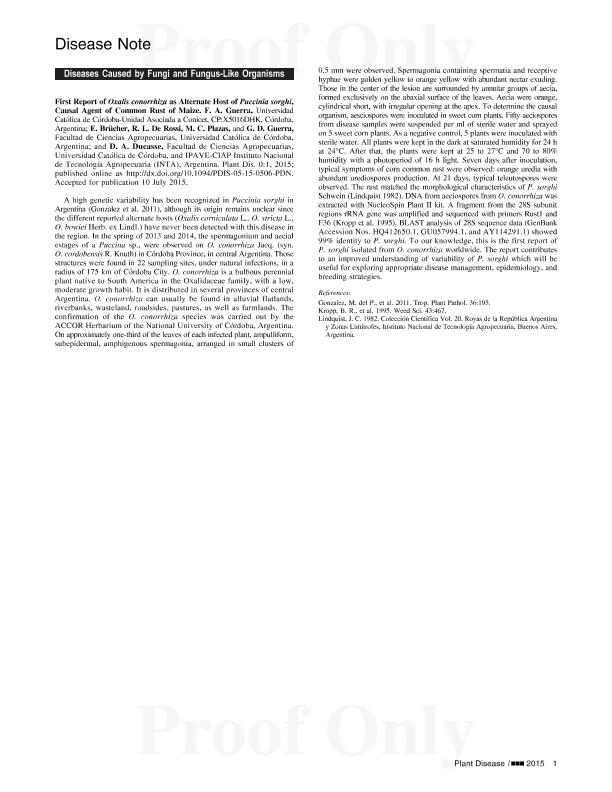Artículo
First report of Oxalis conorrhiza as alternate host of Puccinia sorghi, causal agent of common rust of Maize
Guerra, Fernando Andres ; Brücher, Elsa
; Brücher, Elsa ; de Rossi, Roberto Luis; Plazas, M. C.; Guerra, Gustavo Dario; Ducasse, Daniel Adrián
; de Rossi, Roberto Luis; Plazas, M. C.; Guerra, Gustavo Dario; Ducasse, Daniel Adrián
 ; Brücher, Elsa
; Brücher, Elsa ; de Rossi, Roberto Luis; Plazas, M. C.; Guerra, Gustavo Dario; Ducasse, Daniel Adrián
; de Rossi, Roberto Luis; Plazas, M. C.; Guerra, Gustavo Dario; Ducasse, Daniel Adrián
Fecha de publicación:
02/2016
Editorial:
American Phytopathological Society
Revista:
Plant Disease
ISSN:
0191-2917
Idioma:
Inglés
Tipo de recurso:
Artículo publicado
Clasificación temática:
Resumen
A high genetic variability has been recognized in Puccinia sorghi in Argentina (Gonzalez et al. 2011), although its origin remains unclear since the different reported alternate hosts (Oxalis corniculata L., O. stricta L., O. bowiei Herb. ex Lindl.) have never been detected with this disease in the region. In the spring of 2013 and 2014, the spermagonium and aecial estages of a Puccina sp., were observed on O. conorrhiza Jacq. (syn. O. cordobensis R. Knuth) in Córdoba Province, in central Argentina. Those structures were found in 22 sampling sites, under natural infections, in a radius of 175 km of Córdoba City. O. conorrhiza is a bulbous perennial plant native to South America in the Oxalidaceae family, with a low, moderate growth habit. It is distributed in several provinces of central Argentina. O. conorrhiza can usually be found in alluvial flatlands, riverbanks, wasteland, roadsides, pastures, as well as farmlands. The confirmation of the O. conorrhiza species was carried out by the ACCOR Herbarium of the National University of Córdoba, Argentina. On approximately one-third of the leaves of each infected plant, ampulliform, subepidermal, amphigenous spermagonia, arranged in small clusters of 0.5 mm were observed. Spermagonia containing spermatia and receptive hyphae were golden yellow to orange yellow with abundant nectar exuding. Those in the center of the lesion are surrounded by annular groups of aecia, formed exclusively on the abaxial surface of the leaves. Aecia were orange, cylindrical short, with irregular opening at the apex. To determine the causal organism, aesciospores were inoculated in sweet corn plants. Fifty aeciospores from disease samples were suspended per ml of sterile water and sprayed on 5 sweet corn plants. As a negative control, 5 plants were inoculated with sterile water. All plants were kept in the dark at saturated humidity for 24 h at 24°C. After that, the plants were kept at 25 to 27°C and 70 to 80% humidity with a photoperiod of 16 h light. Seven days after inoculation, typical symptoms of corn common rust were observed: orange uredia with abundant urediospores production. At 21 days, typical teleutospores were observed. The rust matched the morphological characteristics of P. sorghi Schwein (Lindquist 1982). DNA from aeciospores from O. conorrhiza was extracted with NucleoSpin Plant II kit. A fragment from the 28S subunit regions rRNA gene was amplified and sequenced with primers Rust1 and F36 (Kropp et al. 1995). BLAST analysis of 28S sequence data (GenBank Accession Nos. HQ412650.1, GU057994.1, and AY114291.1) showed 99% identity to P. sorghi. To our knowledge, this is the first report of P. sorghi isolated from O. conorrhiza worldwide. The report contributes to an improved understanding of variability of P. sorghi which will be useful for exploring appropriate disease management, epidemiology, and breeding strategies.
Palabras clave:
Puccinia
,
Corn
,
Zeae Maydis
,
Oxalis
Archivos asociados
Licencia
Identificadores
Colecciones
Articulos(CCT - CORDOBA)
Articulos de CTRO.CIENTIFICO TECNOL.CONICET - CORDOBA
Articulos de CTRO.CIENTIFICO TECNOL.CONICET - CORDOBA
Citación
Guerra, Fernando Andres; Brücher, Elsa; de Rossi, Roberto Luis; Plazas, M. C.; Guerra, Gustavo Dario; et al.; First report of Oxalis conorrhiza as alternate host of Puccinia sorghi, causal agent of common rust of Maize; American Phytopathological Society; Plant Disease; 100; 2; 2-2016; 519-519
Compartir
Altmétricas



